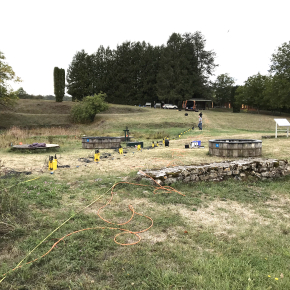Offre de thèse
Signal preservation in the deepest part of the EPICA Dome C ice core and application to paleoclimate reconstruction from 600 000 to 800 000 years ago
Contexte
This project is funded by the ANR project ToBE, with strong links with the european project Beyond
EPICA.
Description
Variations of past climatic and environmental conditions can be retrieved from ice and air bubble composition of ice cores from East Antarctica over the last 800 000 years (EPICA Dome C ice core). A new ice core project should provide records covering the last 1.5 million years (Beyond EPICA ice core). In the deepest part of the ice cores lies the oldest part of the record. The analysis of the deep ice is tricky because the ice layer thinning tremendously affect the temporal resolution: the last 200m of the EPICA Dome C ice core (only 6% of the length of the core) includes 200 000 years of climate record (25% of the age span covered by the core). Moreover, under the influence of (1) elevated temperature, nearly reaching the melting point, and (2) because of the age of the deep ice, diffusion phenomena, extreme growth of the ice crystals, and migration of chemical species within the ice itself can affect the recorded climatic signal.
In the ice itself, preliminary studies showed that the diffusion length can reach several dozens of cm at the bottom of the EPICA Dome C ice core, limiting the interpretation of the water isotope signal. In the gas trapped in the air bubbles (such as O2, N2, CH4 et CO2), diffusive exchange can affect the precision of ice core dating, as well as the reconstruction of pass greenhouse gases concentration. These diffusive effects are still only poorly constrained despite studies of multiple environmental tracers in multiple deep ice cores. One of the main causes is that the resolution at which these cores have been analysed was not high enough to compensate the high levels of thinning the ice underwent. To retrieve a high-quality climatic signal, it is necessary to compensate for both the thinning by increasing the resolution, and for the diffusion by increasing the precision.
In this Phd thesis,various climatic and environmental tracers will be retrieved from the deepest 200m of the EPICA Dome C ice core which covers the period from 600 000 to 800 000 years before today. Specifically, we will study the elementary and isotopic composition of O2 in the air trapped in the ice as a dating approach, as well as the water isotopic composition in order to reconstruct the high frequency temperature variations. In collaboration with the Institute of Geosciences and Environment (Grenoble, France), we will study how the diffusion and thinning processes affect the greenhouse gases (CH4 and CO2) concentration. This PhD project include an analytical part of ice core analysis, as well as interpretation of the results using simple models of the diffusion processes on the ice core signal. The results obtained on the EPICA Dome C ice core will then be generalised to the Beyond EPICA ice core currently being drilled.
Supervisors: Amaëlle Landais () and Mathieu Casado ()
Compétences requises
This project targets a student interested by paleoclimate studies with strong basis in Physics and/or Geosciences. Strong teamwork skills will be required with collaborations outside of LSCE in France
or abroad. A proficient English level is needed (French optional).






